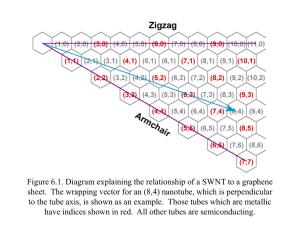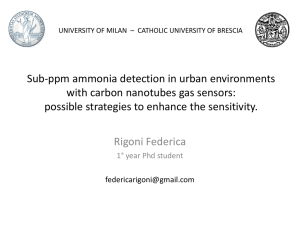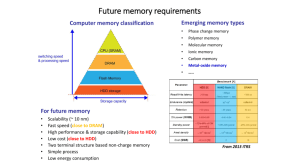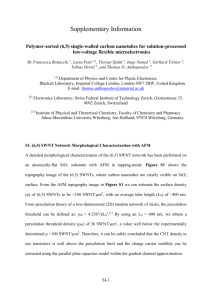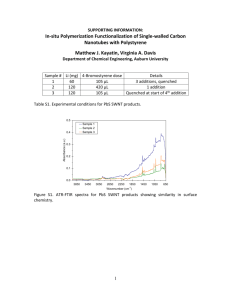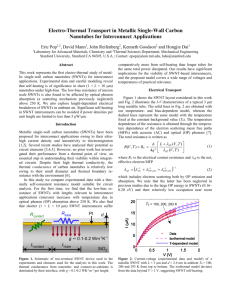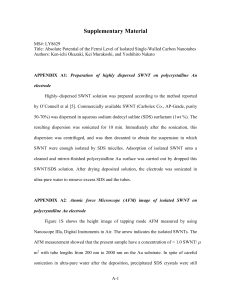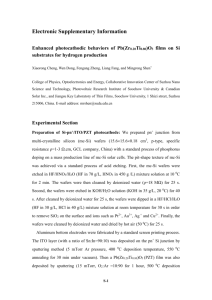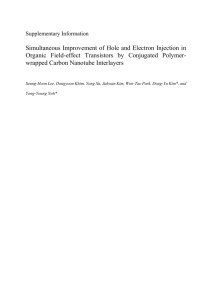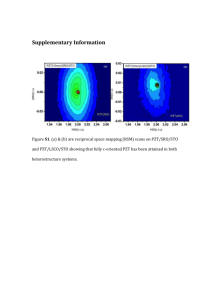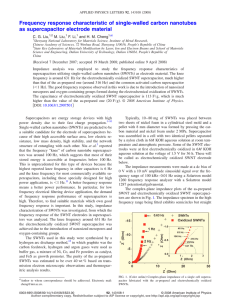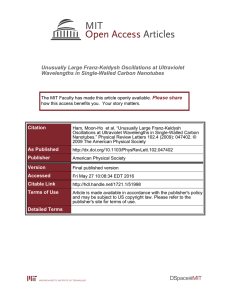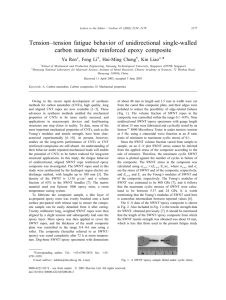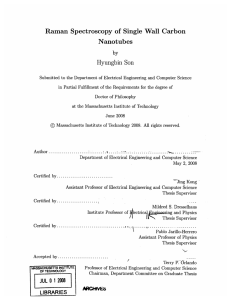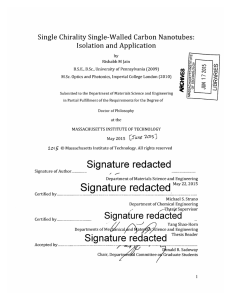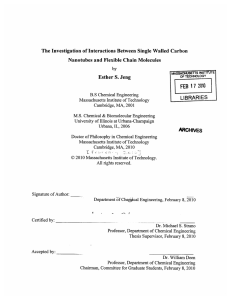Supplemental Material (to be included in the Electronic Physics
advertisement
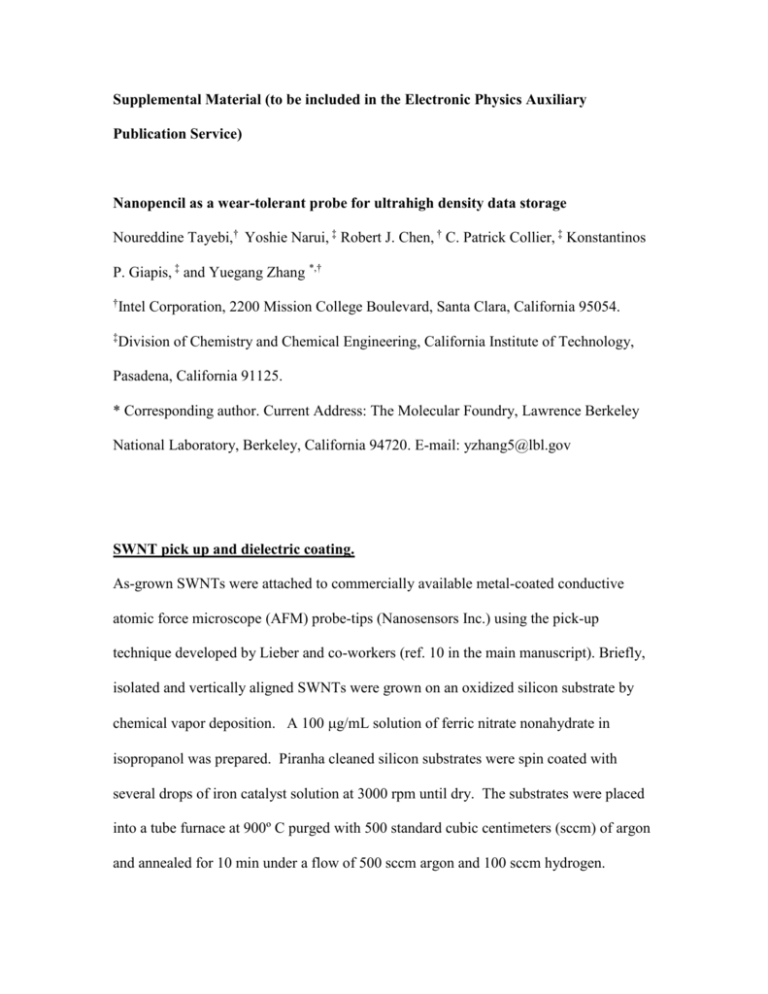
Supplemental Material (to be included in the Electronic Physics Auxiliary Publication Service) Nanopencil as a wear-tolerant probe for ultrahigh density data storage Noureddine Tayebi,† Yoshie Narui, ‡ Robert J. Chen, † C. Patrick Collier, ‡ Konstantinos P. Giapis, ‡ and Yuegang Zhang *,† † Intel Corporation, 2200 Mission College Boulevard, Santa Clara, California 95054. ‡ Division of Chemistry and Chemical Engineering, California Institute of Technology, Pasadena, California 91125. * Corresponding author. Current Address: The Molecular Foundry, Lawrence Berkeley National Laboratory, Berkeley, California 94720. E-mail: yzhang5@lbl.gov SWNT pick up and dielectric coating. As-grown SWNTs were attached to commercially available metal-coated conductive atomic force microscope (AFM) probe-tips (Nanosensors Inc.) using the pick-up technique developed by Lieber and co-workers (ref. 10 in the main manuscript). Briefly, isolated and vertically aligned SWNTs were grown on an oxidized silicon substrate by chemical vapor deposition. A 100 g/mL solution of ferric nitrate nonahydrate in isopropanol was prepared. Piranha cleaned silicon substrates were spin coated with several drops of iron catalyst solution at 3000 rpm until dry. The substrates were placed into a tube furnace at 900º C purged with 500 standard cubic centimeters (sccm) of argon and annealed for 10 min under a flow of 500 sccm argon and 100 sccm hydrogen. Methane was added at 1000 sccm for 7 min followed by a return to annealing conditions for 10 min. Finally, the furnace was cooled to room temperature under argon. Then, the metal-coated tips were used to image the vertically grown SWNTs using a Digital Instruments multimode AFM with a Nanoscope IV controller. During scanning, the probe-tips picked up individual SWNTs (or a bundle of SWNTs), which attached to the probe-tips by van der Waals forces and thus created SWNT-based probes. Subsequently, the SWNT probe-tips were placed on a grounded electrode in a lowpressure glass reactor. An argon gas flow at 7.5 sccm was introduced to the reactor through a bubbler containing tetraethyl orthosilicate (TEOS) liquid kept at 20oC. The reactor pressure was controlled at 95 mTorr. Then, an inductively coupled plasma was struck upstream of the electrode at a power of 100 Watts and a frequency of 13.56 MHz. The SiOx deposition continued for two minutes. Successful nanopencil fabrication was verified using a Phillips EM420 transmission electron microscope (TEM) operating at 120 kV. SWNT electrode exposure. The SWNT electrode exposure, or nanopencil “sharpening”, was performed using an Asylum Research MFP-3D scanning probe microscope. This is achieved by repetitively scanning a 20×20 µm area of a conductive diamond film with a root mean squared roughness of 9 nm (a part of the base of a conductive diamond AFM tip from Nanosensors inc.). The scanning was performed under contact mode at a speed of 100 µm/s while applying a 0.5 V bias between the nanopencil and the diamond surface. The height and current signals were simultaneously monitored and recorded (Fig. 2) using the conductive AFM module. A force of 5 nN was used for all the SWNT electrode exposures. Scanning is stopped once the current starts to flow indicating that the SWNT electrode is exposed. A smaller (1×1 µm area) scan was then performed at a 2.5 µm/s speed and I-V curves were taken at highly conductive spots identified in the current distribution scan to confirm the nanopencil conductivity. Successful electrode exposures were further verified using a Phillips EM420 TEM operating at 120 kV. Data write and read. The write/read experiments were performed using an Asylum Research MFP-3D scanning probe microscope. The nanopencils were used as conducting probes to write inverted domain dots on the PZT films following the same method described in ref. 1 and 2. The ferroelectric PZT film was initially polarized in an up-ward direction. A nanopencil probe was first brought into contact with the film surface. A positive electrical pulses (varying from 5 to 10 V) with a pulse width of 100 µs was then applied to the PZT surface through the conductive nanopencil core. The local down-ward electric field could flip the polarization of a certain PZT film volume and formed a down-ward polarization domain which could be used as a bit for data storage. The ferroelectric domain was imaged using piezoresponse-force microscopy (PFM) where domain walls showed dark contrast in amplitude images and the inverted domains showed 180° phase shift to the background film. Calculations of nanopencil buckling and bending forces. 2 The Euler buckling force is equal to FEuler EI 0.67 L2 , where L and EI are the length and product of the Young’s modulus and moment of inertia of the composite nanowire system (ref. 14). For the SWNT/SiOx composite nanopencil system, EI E SW NT E SiO 4 4 4 4 x RSiO R R R , where ESWNT and ESiOx are the SW NT SW NT 0 x 4 E SW NT Young’s modulus of the SWNT and SiOx coating, respectively. RSWNT and R0, are the outer and inner radii of the SWNT and RSiOx is the outer radius of the SiOx coating. Following the method in ref. 15 in the main manuscript, the lateral spring force constant is given by k 4 4 4 4 3 E SW NT RSW NT R0 E SiOx RSiOx RSW NT 3 4L . For the current study, the follolowing values were used: ESWNT = 1.25 TPa; ESiOx = 70 GPa; RSWNT = 4.5 nm (as seen from TEM images); R0 = (4.5 – 0.34) nm; RSiOx = 65 nm (as seen from TEM images). Calculation of wear rate. The wear rate is computed using the following equation Wrate AV (ref. 17 in E R k F 0.5 the main manuscript). k is a nondimentional wear coefficient taken to be 10-6 (ref. 17); F is the applied force and is equal to 5 nN; A is the contact area defined by the nanopencil dimensions with an outer radius of 65 nm. V is the sliding velocity and is equal to be 50 1 12 1 22 mm/s; E is the composite modulus and is given by E E E2 1 1 , where E1 and E2 and the Young’s modulus of the SWNT/SiOx composite nanopencil system and the PZT film, and are taken to be equal to 76.6 and 123 GPa, respectively; 1 and 2 are the Poisson’s ratio of the composite nanopencil system and the PZT film, and are taken to be equal to 0.17 and 0.3, respectively. and 1/R are the composite RMS and mean curvature of the summits of the contacting surfaces (nanopencil and PZT film) and are determined from AFM measurements to be 0.2 nm and 1/26 nm, respectively. The wear rate equation corresponds to the elastic wear regime (ref. 17). The elastic wear regime is satisfied when the mean pressure, p m F H A 1 2 1 , where H is the hardness of the 2 nanopencil and is taken to be that of SiOx; is a constant and is equal to 9 (ref. 17); µ is the friction coefficient and is calculated using Eqs. (1), (6), (10) and (11) in ref. 16, by modeling the contacting surfaces as two contacting rough surfaces where contact occurs at the asperity level (see ref. 16). The model takes into account the effects of adhesion, and elastic/plastic deformations between the contacting asperities. The friction coefficient, µ is estimated to be 0.855. For a SiOx hardness of 9 GPa, pm F H 3.8 10 4 GPa A 1 2 elastic wear regime. 1 3.3GPa . Thus the system operates within the 2
